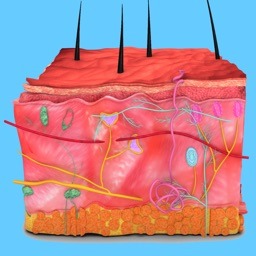We provide knowledge about on health topics, empowering readers to make informed decisions for a healthier, happier life. Lenstapesmed.com hosts a comprehensive health information blog, delivering insightful articles, expert advice, and up-to-date insights on wellness, medical breakthroughs, and lifestyle tips.
Don't wanna be here? Send us removal request.
Text
Test Your Knowledge about skin, hair, nails with the Integumentary System Quiz.
Explore the skin you're in with our Integumentary System Quiz! Dive into this interactive experience and test your knowledge about skin, hair, nails, and more. Discover fascinating facts while uncovering the secrets of your body's largest organ system. learn more about the human body.

0 notes
Text
Heart Attack vs. Cardiac Arrest: Unveiling the Critical Distinctions
Heart health is a topic that often brings confusion, especially when terms like “heart attack” and “cardiac arrest” are used interchangeably. But in reality, these are two distinct medical emergencies, each with its own causes, symptoms, and implications. Understanding the difference between a heart attack and cardiac arrest can be critical in recognizing the signs and seeking timely medical help.
Heart Attack: A Circulation Problem
A heart attack, medically known as a myocardial infarction (MI), occurs when there’s a blockage in an artery, leading to restricted blood flow to a part of the heart muscle. This lack of blood supply causes the heart cells supplied by that artery to begin dying, and the longer the artery remains blocked, the more damage the heart muscle endures.
Symptoms of a Heart Attack
Chest Pain: This often manifests as pressure, heaviness, tightness, or squeezing across the chest.
Radiating Pain: It can extend to the arms (typically the left arm), jaw, neck, back, and abdomen.
Breathing Difficulty: Shortness of breath or difficulty breathing.
Sweating: Profuse sweating, often accompanied by a cold sweat.
Nausea: A feeling of queasiness or actual vomiting.
Lightheadedness: Feeling dizzy or lightheaded, sometimes leading to fainting.
Read more health related blog -https://lenstapesmed.com/
Cardiac Arrest: An Electrical Problem

Symptoms of Cardiac Arrest
Sudden Collapse: Without warning, the person collapses or faints.
Abnormal Breathing: Irregular gasping or choking sounds, known as agonal breathing.
Muscle Twitching: Involuntary muscle movements.
While both cardiac arrest and heart attacks are serious conditions related to heart health, their causes and immediate symptoms differ significantly.
Underlying Risks for Heart Conditions
The underlying risks for both heart attacks and cardiac arrest are quite similar and often interconnected. These include:
Coronary Artery Disease: The primary cause of heart attacks, characterized by artery blockages.
Contributing Factors: Smoking, diabetes, high cholesterol, physical inactivity, obesity, high blood pressure, and a family history of early heart disease.
Additionally, various other heart conditions can increase the risk of cardiac arrest, such as weak heart muscle (cardiomyopathy), heart valve abnormalities, and inherited electrical system disorders like long QT syndrome. Substance abuse, particularly drugs like cocaine or amphetamines, as well as opioid overdoses, also heighten the risk of experiencing a cardiac event.
Exercise and Heart Health
Interestingly, while exercise is generally beneficial for heart health, especially in reducing the risks associated with heart-related issues, there is a slight increase in the risk of cardiac arrest during and shortly after intense physical activity, particularly in individuals who are out of shape. However, the overall chances of experiencing cardiac arrest during any exercise session are incredibly low, at approximately one in 1.5 million sessions, and are outweighed by the numerous protective benefits that regular exercise offers for the heart.
Conclusion
In summary, distinguishing between a heart attack and cardiac arrest is crucial for understanding their respective causes, symptoms, and risks. Prompt recognition of symptoms and seeking immediate medical assistance can significantly improve the chances of survival and minimize the potential damage to the heart in either scenario. Understanding the factors that contribute to heart health and adopting a lifestyle that mitigates these risks is essential for maintaining a healthy heart and reducing the likelihood of experiencing these life-threatening events.
Source- https://lenstapesmed.com/heart-attack-versus-cardiac-arrest/
0 notes
Text
Confronting Birth Defects or congenital malformations : Diagnoses and Care Strategies
The miracle of birth brings with it the possibility of congenital abnormalities, often referred to as birth defects. These conditions, arising from various factors, can impact a child's health and development. Understanding how these anomalies are diagnosed, the significance of preconception examinations, available treatment options, and the crucial aspects of caring for affected infants are pivotal in navigating this intricate landscape of healthcare.
Diagnosis of Birth Defects
Diagnosing birth defects encompasses a spectrum of approaches, both pre and postnatal. Advanced medical technologies allow the detection of certain anomalies before birth through procedures like ultrasound, amniocentesis, and chronic villus sampling (CVS). These methods offer vital insights into potential issues like Down syndrome and spina bifida, empowering parents with information to emotionally prepare and plan for their child's care needs.

Postnatally, physical examinations and specialized blood tests facilitate the identification of birth defects soon after a baby's arrival. This combination of pre and postnatal assessments helps healthcare professionals tailor care and interventions promptly.
What are the major causes of congenital abnormalities?
Congenital abnormalities have various causes, including genetic factors, environmental influences, and certain infections during pregnancy. Genetic mutations or chromosomal abnormalities play a significant role, as do environmental factors like exposure to toxins, drugs, or alcohol during fetal development. Infections such as rubella, toxoplasmosis, or Zika virus contracted by the mother during pregnancy can also contribute to congenital anomalies. Additionally, factors like maternal health, nutrition, and lifestyle choices can impact fetal development, potentially leading to congenital abnormalities. Understanding and addressing these causes are vital for prevention and early intervention.
Significance of Preconception Examinations
A preconception examination serves as a cornerstone in ensuring a healthy pregnancy journey. It involves a comprehensive evaluation aimed at understanding overall health and identifying potential risk factors that might complicate pregnancy. Here are key components of a preconception examination:
Family Medical History
Assessing the medical history of both biological parents’ aids in uncovering hereditary conditions or medical issues that might influence the child's health.

Genetic Testing
Pre-pregnancy genetic tests enable the detection of potential genetic disorders, empowering proactive steps to mitigate risks.
Personal Medical History
Evaluating an individual's medical conditions, previous surgeries, and pregnancy-related complications helps in tailoring care plans.
Vaccination Status
Checking immunity to diseases like rubella, vital in preventing miscarriages or birth defects, underscores the importance of vaccinations before conception.
Infection Screening
Identifying and treating infections that could harm both the mother and fetus is pivotal for ensuring a healthy pregnancy.
Treatment Options for Birth Defects
While most birth defects aren’t curable, managing symptoms and offering specialized care are vital. However, certain conditions might have treatment options:
Gene Therapy
In cases where genes are missing or defective, gene therapy steps in to replace or rectify these anomalies. Severe combined immunodeficiency diseases (SCID) exemplify a rare condition where gene therapy has shown promise.
Enzyme Replacement Therapy
Addressing genetic defects involves replacing missing or defective enzymes. Conditions like Gaucher disease have seen advancements through enzyme replacement therapy.
Prenatal Treatments
Early diagnosis allows for prenatal treatments like surgeries to address specific congenital malformations, such as urinary tract blockages or rare lung tumors, enhancing the chances of a healthier outcome for the baby.
Which disease is congenital?
Congenital diseases are conditions present at birth, stemming from genetic factors, infections, or environmental influences during fetal development. These encompass a wide range of health issues, such as heart defects, Down syndrome, cleft lip or palate, and spina bifida, among others. These conditions might arise due to genetic mutations, exposure to toxins, or infections contracted by the mother during pregnancy. They can impact various systems in the body, leading to lifelong challenges for affected individuals. Early detection and appropriate management are crucial in addressing congenital diseases and improving outcomes.
Care for Birth Defects: The Role of Specialized Centers
Specialized fetal care centers, like the Maternal Fetal Care Center (MFCC), play a pivotal role in managing complex fetal anomalies. These centers offer comprehensive support and management for intricate conditions. Pioneering interventions, like in utero cardiac treatments, showcase the innovative strides these centers are making in caring for congenital abnormalities. Advancements in treating conditions like congenital diaphragmatic hernia reflect the dedication and progress of these specialized facilities.
Conclusion
Understanding congenital abnormalities involves a multidimensional approach encompassing diagnosis, preconception care, treatment options, and specialized care facilities. Empowering parents with information, offering proactive healthcare strategies, and leveraging advancements in medical science are crucial in providing the best possible care for infants affected by birth defects. As science continues to advance, the prospects for managing and treating these anomalies grow, offering hope and possibilities for affected families.
By prioritizing awareness, proactive healthcare, and ongoing research, society can strive to offer comprehensive support and care for those impacted by congenital abnormalities, ensuring a brighter and healthier future for generations to come.
1 note
·
View note